IN THIS ISSUE
- Latest tegu sightings
- Terry's favorite oriole
- Go-to site for rare wildlife
- What's new with bird flu
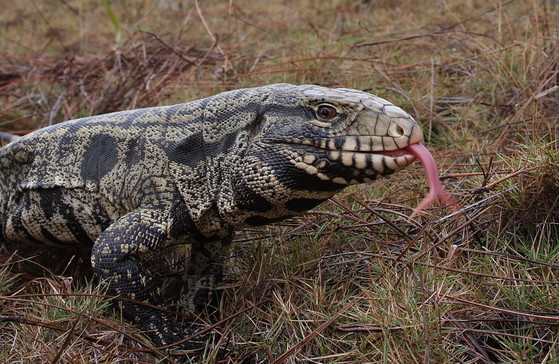 Adult Argentine black and white tegu (Dustin Smith)
And then there were three. At least.
Two Argentine black and white tegus turned up dead recently in Toombs County. One was run over on U.S. 280 between Lyons and Reidsville. The other was shot about eight miles from there when a Nora Corley Road resident found two of the big South American lizards on his porch. The second tegu got away.
These tegus, the first verified in Toombs and Tattnall counties this year, point to the persistence of the invasive reptiles in this part of southeast Georgia as well as a possible pattern in sightings.
As for the Nora Corley Road tegus, DNR senior wildlife technician Jim Gillis remembered a tegu cornered in a chicken house a quarter of a mile away two years ago, plus talk of two tegus the same year at a nearby crossroads. Add in the U.S. 280 roadkill and eight other tegus confirmed since 2020, and “things have been very active in this large area the last three years,” Gillis said.
DNR is working with residents and partners such as Georgia Southern University to document and eradicate tegus in Toombs and Tattnall. Although popular in the pet trade, these reptiles grow up to 4 feet long, eat everything from eggs to small animals and in the wild pose a threat to native wildlife.
Georgia’s only suspected wild population of tegus likely came from accidental or intentional releases. But the state isn’t alone. Tegus have been reported in South Carolina and in more than half of Florida’s counties.
Gillis provides loaner traps and advice to locals who spot a tegu. Trail cameras are used to help monitor traps. DNR also encourages reporting any tegu seen in the wild, alive or dead. Tegus can be trapped or killed year-round with the landowner's permission and following animal cruelty and local ordinances.
Why the urgency? Studies show that once an invasive species becomes established, it is almost impossible to eradicate.
SEE A TEGU, TELL DNR
Report tegus sightings in Toombs, Tattnall or elsewhere in Georgia.
Learn more about tegus at georgiawildlife.com/tegus.
 Male orchard oriole (Ty Ivey/GNPA)
By TERRY W. JOHNSON
Hands down, my favorite oriole is the orchard oriole. This might come as a surprise since it is North America’s smallest oriole and isn’t as colorful as Georgia’s largest and better-known oriole – Baltimore orioles.
However, I find orchard orioles beautiful. Also to their credit, they are most likely to nest in yards throughout most of the state. Orchard orioles nest in my yard every year, providing opportunities to see and hear them throughout the nesting season.
Each April, I look forward to that special morning when I hear the first orchard oriole of spring. This year, I caught the bird’s rambling song on April 11. …
Read Terry’s column for more on orchard orioles, including their amazing nests.
Terry W. Johnson is a retired DNR program manager and executive director of TERN, friends group of the agency's Wildlife Conservation Section. Check out past columns, his Backyard Wildlife Connection blog and his book “A Journey of Discovery: Monroe County Outdoors.” Permission is required to reprint a column.
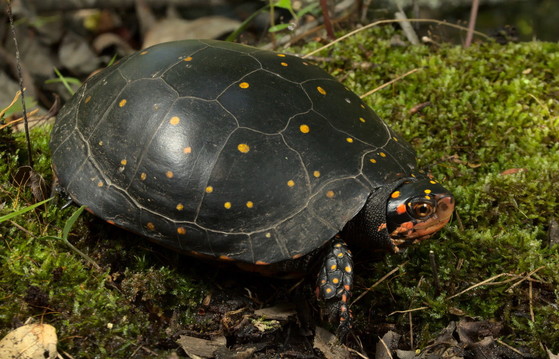 Spotted turtle (Ben Stegenga/The Orianne Society)
By ETHAN HATCHETT
The first thing that comes to mind when thinking about downtown Savannah is usually not a rare turtle. But using DNR’s Georgia Biodiversity Portal, you can see that a spotted turtle (Clemmys guttata) was found near the city’s historic landmarks and famous restaurants less than five years ago.
Savannahians, this seldom-seen reptile and more could be lurking right under your nose.
Greg Krakow, biodiversity conservation data manager with the DNR Wildlife Resources Division, believes becoming familiar with the at-risk wildlife in your area is important. “It gives you a personal connection to conservation,” Krakow said. “It raises awareness and changes the way people see things.”
The Biodiversity Portal makes that vision clearer no matter where you are in Georgia and for everyone from middle school students to environmental consultants.
The unique website allows all to explore rare plants and animals. Data can be sifted by family group and species. You can select to view only federal or state protected species. Searches can be focused further by layers of location, including county, watershed and ecoregion.
“Many states charge money or restrict access to this kind of information,” Krakow said. “But we decided from the start that this portal would be free. This information is just too important.”
Along with providing fascinating details about rare plants and animals, the portal contains identification keys as well as in-depth looks at many DNR conservation projects, such as forest management for gopher tortoises, Georgia’s state reptile.
Krakow stressed the connection between wildlife and their habitats. “The habitat these animals live in is essential. Without these habitats there is no wildlife.”
Clemmys guttata may be hard to find, but the Georgia Biodiversity Portal isn’t. Just go to georgiabiodiversity.com/portal.
You can also access it by visiting georgiawildlife.com, hovering over “Education” and clicking “Educational Resources.” The portal is linked under “Teaching Resources.”
Ethan Hatchett is a DNR Wildlife Resources Division communications assistant.
LOOKING FOR LICHENS?
The Biodiversity Data Portal has just added a Lichens of Georgia section. Based on years of research by Malcolm Hodges and Sean Beeching, the section profiles the state's 923 lichen species, including range maps, photos and even lichen terms.
 Black vultures, a growing focus for HPAI (Noppadol Paothong/MDC)
As avian influenza spreads across the continent, Georgia-related updates include:
- There have been no new confirmed cases involving bald eagles or other species in the state for two months. Initial results from DNR’s eagle nest surveys indicate that the impact of highly pathogenic avian influenza (HPAI) – specifically, H5N1 2.3.4.4b – on nesting was limited to coastal counties, where nest success declined 30 percent (“Eagles and bird flu,” April).
- The number of vultures dying from HPAI is surging. In Florida, black vulture is the species most commonly diagnosed with the disease. Eating infected carrion and congregating in groups puts “nature’s undertakers” at high risk. In Georgia, report multiple sick or dead vultures to DNR at (478) 994-1438.
- Some are worried that feeding birds will help spread HPAI. But research suggests the virus will not become widespread in songbirds – except possibly in scavenging species such as crows and in areas of increased risk of transmission, such as near affected poultry farms. However, those who feed birds are advised to keep feeders, feeding stations and birdbaths clean.
In other parts of the U.S., HPAI has been confirmed in wild turkeys in Montana and Wyoming and red fox kits in Michigan and Wisconsin.
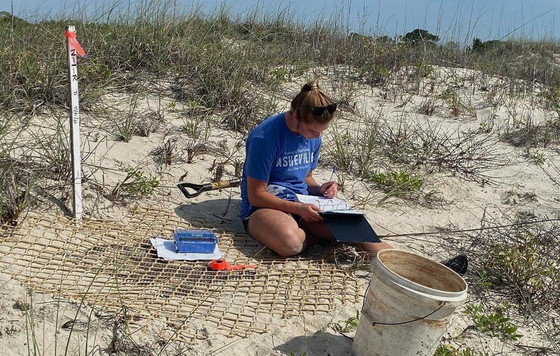 DNR sea turtle tech Isabel Johnson relocates a Sapelo Island nest. (Mark Dodd/DNR)
Sea turtle nesting season is off to a strong start. The Georgia Sea Turtle Cooperative reported the year’s first loggerhead nests on May 3 and has since marked and protected 200-plus on barrier island beaches. Updates.
An Orangeburg, S.C., man who illegally trapped thousands of turtles in Georgia and shipped them to California – for eventual sale to Asia – has been sentenced to a year in prison and fined $10,000. Following an investigation by federal and state agencies including DNR, Nathan Horton plead guilty to the Lacey Act charges.
While most bald eagles avoid people when nesting, a Lake Oliver pair raised three eaglets in a pine beside the private Big Eddy Club, much to members’ delight. The nest was the only one DNR nest survey leader Dr. Bob Sargent checked this year that had more than two young. Coming next month: eagle nest totals.
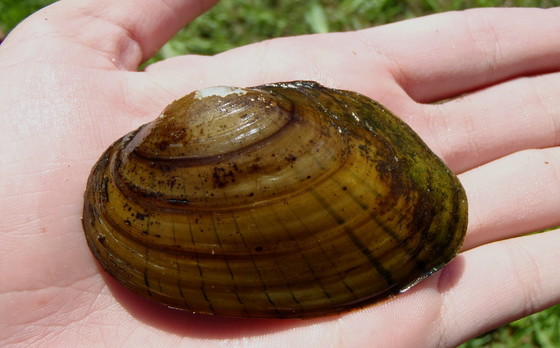 Finelined pocketbook (Anakela Escobar/DNR)
Mussel monitoring that capped a five-year study of northwest Georgia’s Holly Creek documented more federally threatened Alabama moccasinshells and finelined pocketbooks as well as – for the first time since 2015 – the endangered southern pigtoe. Combined with fish and aquatic insect surveys by UGA’s River Basin Center, the work is measuring the impact of restoration efforts at the species-rich stream.
Bound for the beach? Help protect shorebirds and seabirds that nest, rest and feed here by avoiding posted sites, walking below the high-tide line, watching the birds only from a distance and backing away from any nesting birds you accidentally disturb. Learn more.
Calls for Congress to consider Recovering America’s Wildlife Act continue, with proponents like the National Wildlife Federation holding virtual rallies with birders and other groups. The federal legislation would devote up to $1.4 billion a year for states and tribes to restore and protect thousands of species.
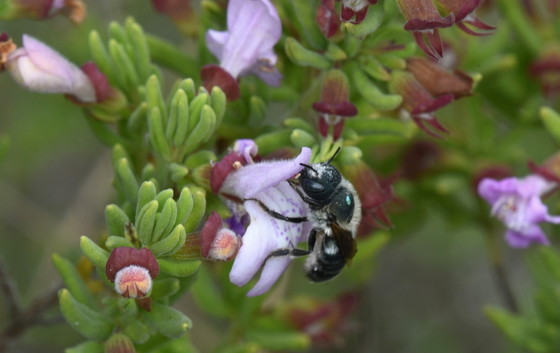 Blue calamintha bee on Ashe’s calamint (Jaret Daniels/Florida Museum of Natural History)
Quick hits:
- A recent search of scrub habitat on Ohoopee River dunes found blooming Ashe’s calamint but not the sought-for blue calamintha bee, which relies on the plant and is petitioned for federal listing (video).
- 2022 could be a standout year for southeastern American kestrels in the Fall Line sandhills region, with more than 18 nests so far and many more nest boxes to check, according to DNR senior wildlife biologist Nathan Klaus.
- If bears are active in an area, birdseed can be a tempting food source and temporarily taking down birdfeeders is the BearWise way to avoid conflicts.
-
One of the conservation bills Gov. Brian Kemp signed into law will reinstate the Georgia Conservation Tax Credit, a popular land-protection incentive.
- Dead trees give life, providing food for insects – which other animals eat – and nesting habitat for some species, while stump holes also offer homes and hunting grounds. (For more, see #ManagementMonday on Facebook.)
-
National Boating and Fishing Week in Georgia will include two fish-for-free Saturdays (no license needed), on June 4 and 11.
- #WildTurtleWeek, a social media “shell-a-bration” of turtles, starts Monday.
 Fire crew leader Maria Loughran featured on RealWomeninTimber
Names in the news: RealWomeninTimber featured DNR southeast Georgia fire crew leader Maria Loughran in social media posts highlighting her work restoring rare plants – such as the pitcherplants pictured – and natural habitats. (In case you missed it, Maria also joined Burner Bob for a post-fire shot last year.) The National Wildlife Federation ran an Earth Day Q&A with DNR Conservation Teacher of the Year Kendall Xides about her efforts to restore the Birdsong Nature Trail at Oak Grove Elementary in Decatur.
WHAT YOU MISSED ...
In the previous Georgia Wild:
- Bald eagles and bird flu
- SOS for right whales
- Globe amaranth’s allure
"Sea turtles begin nesting season in Georgia," WABE-FM (90.1, Atlanta). Update: Associated Press.
"Feds: Man sold illegally trapped turtles from Georgia for high profits in China," The (Macon) Telegraph. News release: U.S. Justice Department.
"Bald eagle family awaits eaglet’s first flight," Pike County Journal-Reporter
"Smaller female right whales have fewer calves," Phys.org
"First right whale of season spotted, triggers fishing closure," CBC
"On the ropes: right whale's fight for survival," The Nature Conservancy
"Give Wildlife a Chance Poster Contest winners announced," AllonGeorgia
"Shorebirds nesting on local beaches," The Brunswick News
"Bird flu takes toll on bald eagles, other birds," Associated Press
"Angler catches record sunfish in Georgia bass tournament," USA Today and others via AP. Related coverage: Georgia Outdoor News.
"Habitat loss, climate change threaten coast’s reptiles," The Current
"Brunswick looks at tide control to mitigate rising seas," GPB
(video) "Use extra vigilance around wildlife in spring," WAGA-TV (ch. 5, Atlanta)
"Kemp signs bills to strengthen forestry, promote conservation," Office of the Governor
"Forest degradation in Canada causes bird decline," The Wildlife Society
"Ivory-billed woodpecker not extinct, researchers say," The Guardian
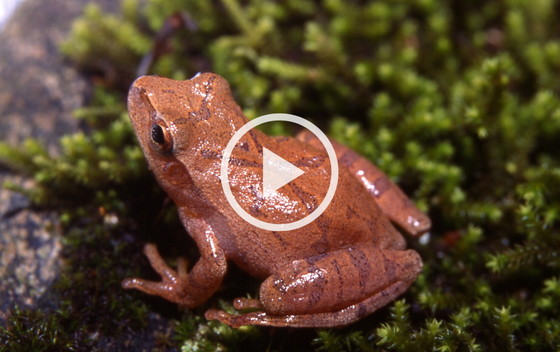 Spring peepers calling, DNR
Vulture soccer, DNR
(audio) "The Brief" podcast on DNR right whale surveys (starting at 5:38 minutes), WABE-FM (90.1, Atlanta)
Young angler lands trout at Trout Fishing with Mom (Unicoi State Park), DNR
Prescribed fire shooters, DNR
"Early emergence of garter snakes at Narcisse dens," Winnipeg Free Press (Manitoba)
Texas angler catches 8-foot-long alligator gar, Wild Life
CREDIT
Georgia Wild masthead: egg collected for genetic analysis from a Jekyll Island sea turtle nest (William Hicks/Georgia Sea Turtle Center)
Top
|